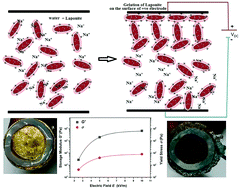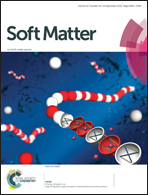Electric field induced gelation in aqueous nanoclay suspensions†
Abstract
Aqueous colloidal LAPONITE® clay suspensions transform spontaneously to a soft solid-like arrested state as its aging or waiting time increases. This article reports the rapid transformation of aqueous LAPONITE® suspensions into soft solids due to the application of a DC electric field. A substantial increase in the speed of solidification at higher electric field strengths is also observed. The electric field is applied across two parallel brass plates immersed in the LAPONITE® suspension. The subsequent solidification that takes place on the surface of the positive electrode is attributed to the dominant negative surface charges on the LAPONITE® particles and the associated electrokinetic phenomena. With increasing electric field strength, a dramatic increase is recorded in the elastic moduli of the samples. These electric field induced LAPONITE® soft solids demonstrate all the typical rheological characteristics of soft glassy materials. They also exhibit a two-step shear melting process similar to that observed in attractive soft glasses. The microstructures of the samples, studied using cryo-scanning electron microscopy (SEM), are seen to consist of percolated network gel-like structures, with the connectivity of the gel network increasing with increasing electric field strengths. In comparison with salt induced gels, the electric field induced gels studied here are mechanically stronger and more stable over longer periods of time.



 Please wait while we load your content...
Please wait while we load your content...